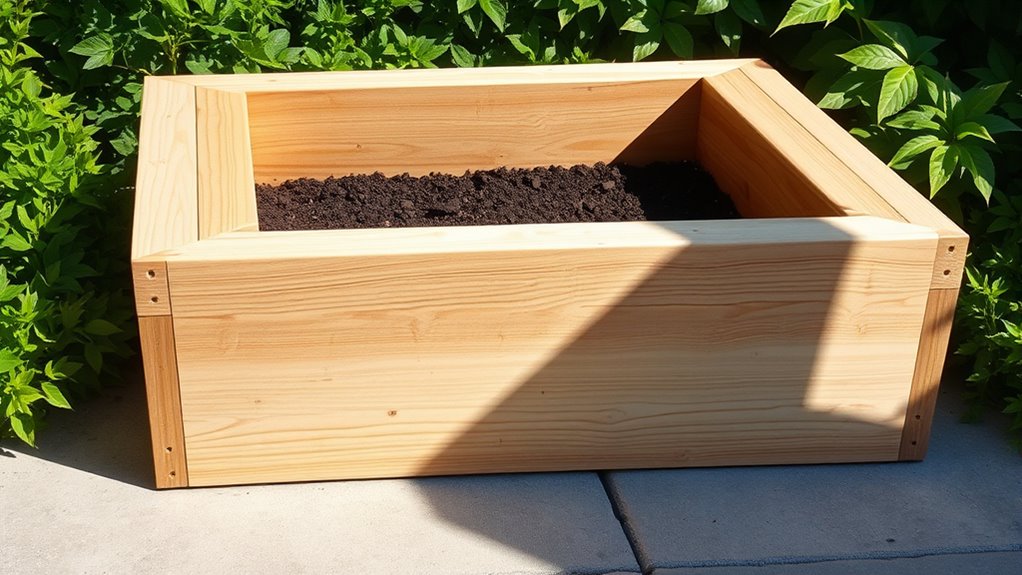To build a simple raised garden bed for your patio, start by choosing a sunny, level spot with good drainage and close to water. Use durable, rot-resistant wood like cedar or composite materials for the frame, and assemble it with weatherproof fasteners. Prepare the ground with a drainage layer and liner, then fill with quality soil, compost, and organic matter. For best results, incorporate watering systems and creative tips — continue for detailed steps to guarantee your garden thrives.
Key Takeaways
- Choose a level, sunny spot near water with proper drainage and no underground obstructions.
- Use rot-resistant wood like cedar or composite, assembled with weatherproof fasteners for durability.
- Line the bed with plastic and add a drainage layer of gravel or coarse sand at the bottom.
- Fill with high-quality soil mixed with compost and organic matter, and create suitable planting holes.
- Incorporate mulch, efficient watering systems, and pest barriers to maintain and extend the garden bed’s lifespan.
Choosing the Ideal Site and Planning Your Bed
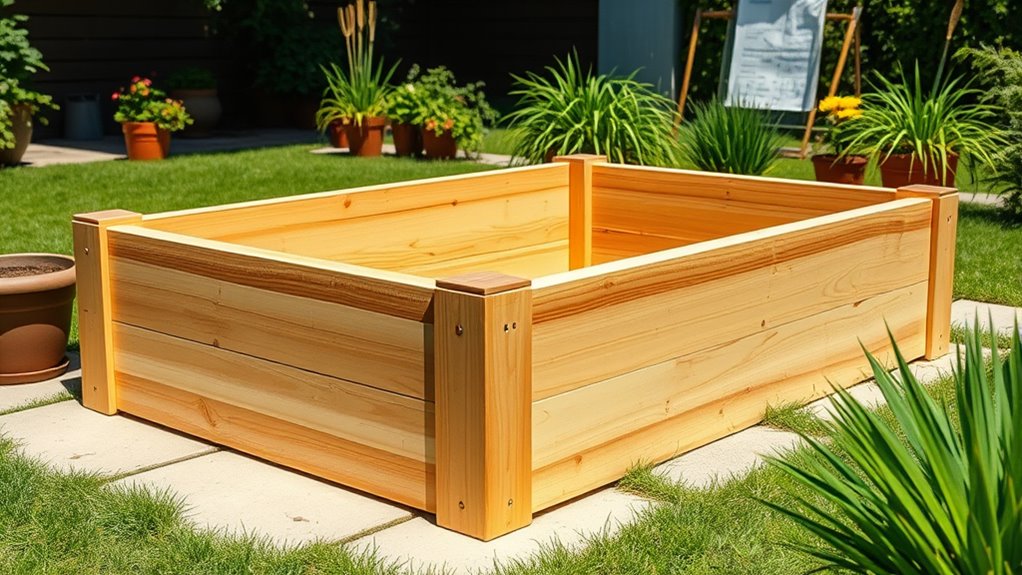
To build a successful raised garden bed on your patio, start by selecting a sunny, level spot that gets at least 6 hours of direct sunlight daily. Your chosen location should support the weight of the raised bed when filled with soil and plants, so evaluate the patio’s surface for stability and proper drainage to prevent water pooling. Additionally, ensure the site is free from underground obstructions and has good drainage to avoid water accumulation, which can harm plant roots and compromise the structure. It’s also important to consider the materials used for the bed to ensure durability and suitability for outdoor conditions. Measure and outline the desired size of your raised bed, typically around 4×6 feet, ensuring it fits comfortably and allows easy access for maintenance and harvesting. Confirm that the site is close to a water source for irrigation and that it offers convenience for regular care. Conducting a utility check helps prevent accidental damage during construction and ensures safety. Incorporating proper drainage techniques into your design will help maintain soil health and prevent waterlogging. Additionally, selecting weather-resistant materials can extend the longevity of your garden bed and reduce maintenance needs. Proper planning and site selection will lead to a thriving and easy-to-maintain garden on your patio.
Selecting Materials and Building the Frame
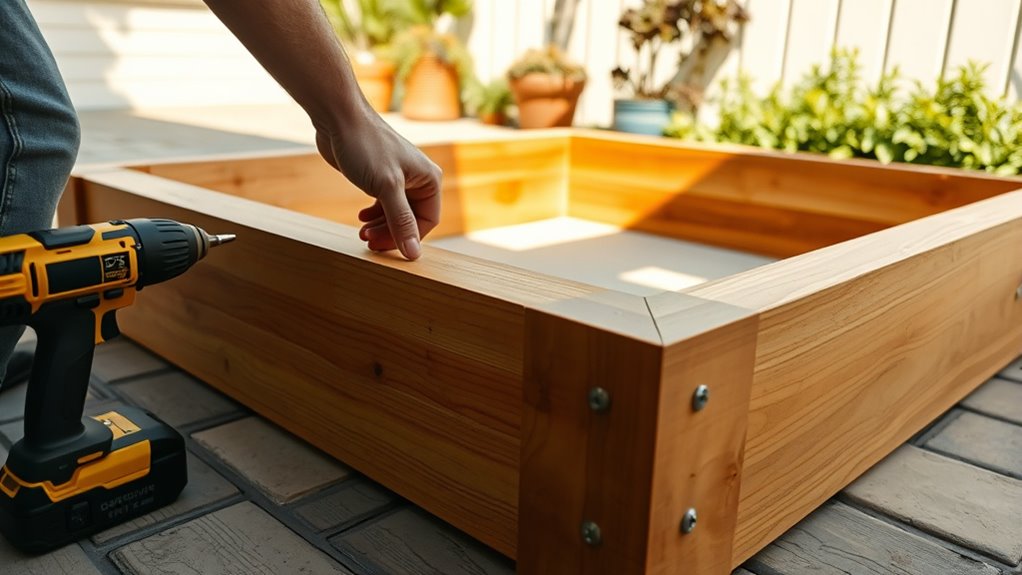
Start by choosing durable, rot-resistant wood like cedar or composite materials to guarantee your garden bed lasts. Measure and mark your boards carefully before cutting. You might also consider incorporating a self-watering system into your design to help maintain consistent soil moisture for your plants. Additionally, selecting materials with weather-resistant properties can further extend the lifespan of your garden bed. Using the right materials, such as water-resistant materials, and precise assembly will create a sturdy, long-lasting foundation for your patio garden. Incorporating natural materials can also enhance the rustic aesthetic of your raised bed and improve its durability over time.
Choosing Durable Wood Types
Choosing the right wood for your garden bed is essential for guaranteeing its durability and longevity. Cedar and redwood are excellent options because they’re naturally water-resistant and resist rot and insects, making them ideal for outdoor use. These woods offer great weathering resistance without chemical treatments. Additionally, selecting wood that meets safety standards ensures the materials are appropriate for outdoor use and won’t pose health risks. If you prefer pressure-treated wood, choose options with non-arsenic treatments like ACQ. However, always line it with plastic to prevent soil contamination—untreated or rot-resistant woods are safer for edible gardens. Proper board dimensions, such as 2x6s or 2x4s, ensure stability and reduce warping or splitting over time. Applying a sealant that is suitable for exterior use can further enhance wood durability, especially for softer options like fir or pine, which require sealing or treatment to withstand outdoor conditions. Using proper sealing techniques can significantly extend the lifespan of your garden bed. Additionally, selecting appropriate fasteners prevents corrosion and maintains the structural integrity of the frame over time. Incorporating weather-resistant hardware can also help improve the overall durability of the garden bed in varying outdoor weather conditions.
Measuring and Assembling Frame
Begin by measuring and marking your desired dimensions on the lumber, using a tape measure and pencil to ensure precision. Carefully cut each board to match your measurements, double-checking angles for square corners. When assembling the frame, attach the sides with screws and reinforce the corners with corner braces or framing angles. It’s important to verify that the frame is level and square by measuring diagonally from corner to corner and adjusting as needed before tightening all fasteners. Using a high-quality measuring tool can help improve accuracy during this process. Use the following table to help plan your measurements:
| Dimension | Length (feet) |
|---|---|
| Short sides | 4 |
| Long sides | 6 |
| Height | 12 inches |
This approach guarantees a sturdy, well-aligned frame ready for planting. Incorporating professional equipment ensures quality and durability in your build. Additionally, selecting durable materials helps ensure your garden bed withstands outdoor conditions over time, especially when using essential oils for outdoor protection.
Preparing the Ground and Lining the Bed
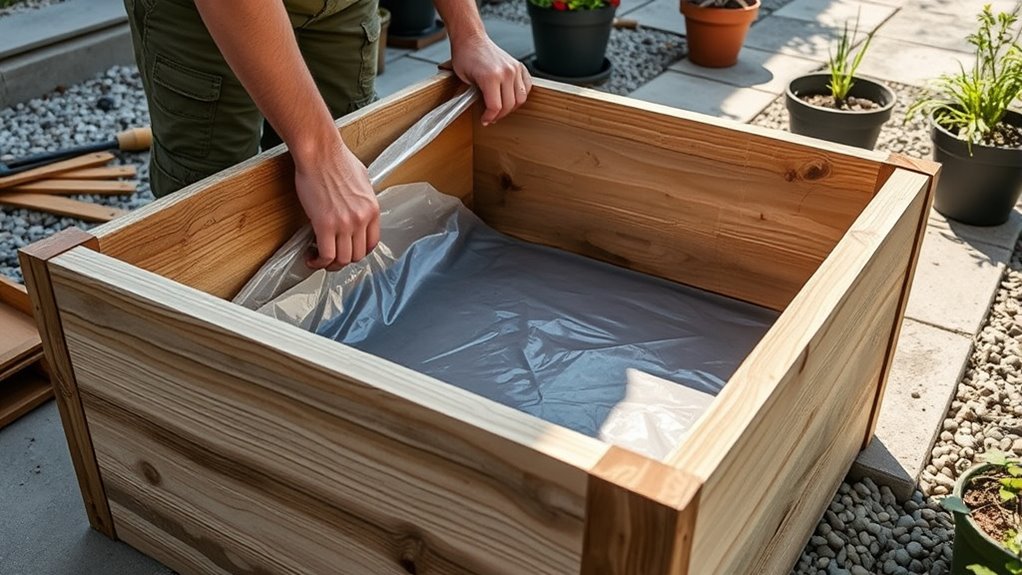
Start by clearing the area of grass, weeds, or debris to create a clean, level surface. Use a level or adjust soil and gravel to guarantee stability and proper drainage. Then, line the bottom of the bed with hardware cloth or landscape fabric to keep weeds out and improve soil containment. Incorporating vertical storage solutions can also help keep gardening tools and supplies organized nearby. Being aware of pinball machine weight is also helpful when planning for home installation, especially if you need to move or position the bed in a specific area. Additionally, considering proper foundation construction ensures the longevity and stability of your raised garden bed, especially on uneven or soft ground. Understanding market growth projections related to gardening and outdoor projects can help you plan for future enhancements and expansions. Considering dream symbols related to growth and stability can provide helpful insights during planning and construction.
Choosing the Best Site
To guarantee your raised garden bed thrives, find a sunny site on your patio that’s level and receives at least 6-8 hours of direct sunlight daily. A level patio ensures stability and helps with plant growth, reducing the risk of soil leakage or uneven moisture.
Clear the area of grass, weeds, and debris for effective soil preparation.
Consider design considerations like creating a drainage layer with gravel or small holes to prevent water pooling.
Lining the bottom with a weed barrier or durable plastic prevents weed intrusion and moisture loss.
The raised bed location should also avoid shade from nearby structures or plants to maximize sunlight exposure.
Proper site selection supports healthy plant growth and simplifies maintenance, making your gardening experience more successful.
Lining for Durability
Lining the bottom of your raised garden bed with durable materials helps protect it from moisture damage and pests. Using a plastic liner or heavy-duty plastic creates a barrier that prevents rot-resistant materials like treated lumber from absorbing excess moisture.
A plastic lining also aids in soil containment and deterring pests such as gophers or burrowing animals. To guarantee proper water flow and avoid waterlogging, add a drainage layer, like gravel or coarse sand, beneath the lining.
Secure the plastic liner around the edges to keep it in place during watering and planting. Proper sealing prevents soil from seeping out and maintains the bed’s durability, making your garden last longer and stay healthier on your patio.
Filling the Bed With Soil and Planting
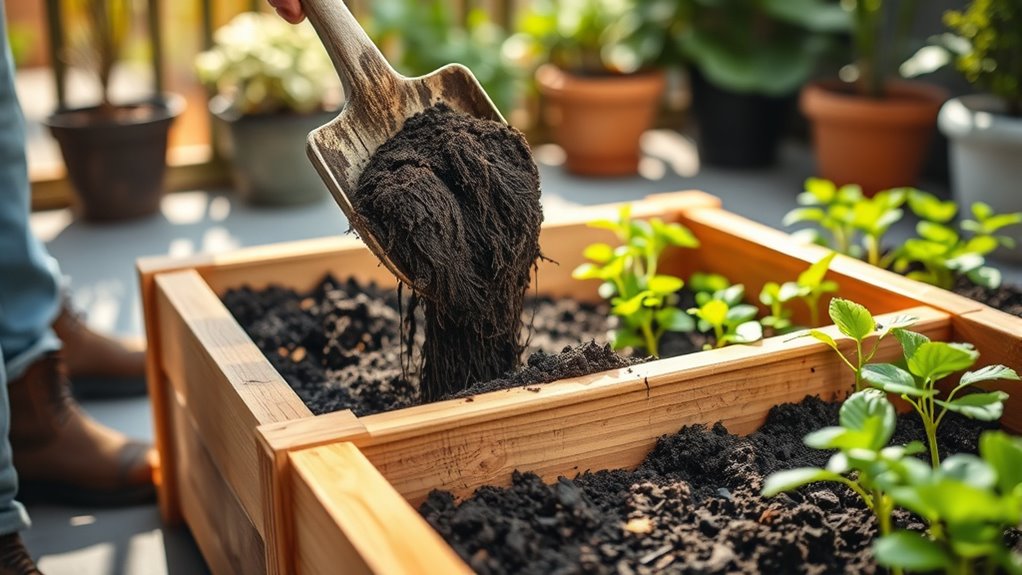
Once you’ve prepared your raised garden bed, filling it with a nutrient-rich soil mixture is essential for healthy plant growth. Use a soil calculator to estimate the right amount based on your bed’s dimensions, avoiding waste. Mix high-quality garden soil with compost and organic matter like aged manure to create a fertile, moisture-retentive environment. Layer the soil and compost evenly, lightly firming it to eliminate air pockets while maintaining loose, well-draining conditions. When planting, make small planting holes for your vegetables, herbs, or flowers, gently covering roots with soil and patting down for good contact. Proper bed filling ensures your plants develop strong roots and access essential nutrients from the soil layer, promoting vigorous growth.
| Step | Action |
|---|---|
| 1 | Use soil calculator to estimate needed volume |
| 2 | Mix soil with compost and organic matter |
| 3 | Layer and lightly firm the soil |
| 4 | Make planting holes for plants |
| 5 | Plant and gently cover roots |
Watering and Maintaining Your Garden
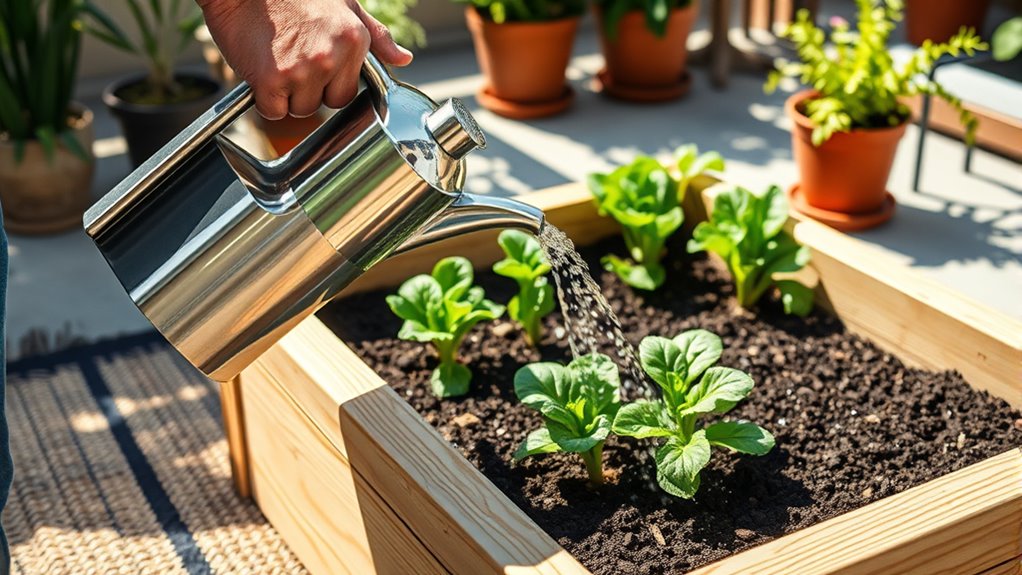
Watering your raised garden bed effectively is key to healthy plant growth, especially during hot or dry weather. Proper watering maintains soil moisture and prevents plants from drying out.
Use drip irrigation, soaker hoses, or timed sprinklers to deliver water directly to the roots, ensuring efficient water use and minimizing waste. Check moisture levels regularly to keep the soil evenly moist; deep watering encourages strong root development and better plant health.
Mulching with organic materials like straw or bark helps retain water, suppress weeds, and regulate soil temperature, supporting water retention. In garden maintenance, focus on deep, infrequent watering rather than shallow, frequent watering, which is better for drought prevention and overall plant vitality.
Proper watering and mulch use keep your garden thriving.
Creative Ideas and Tips for Successful Gardening
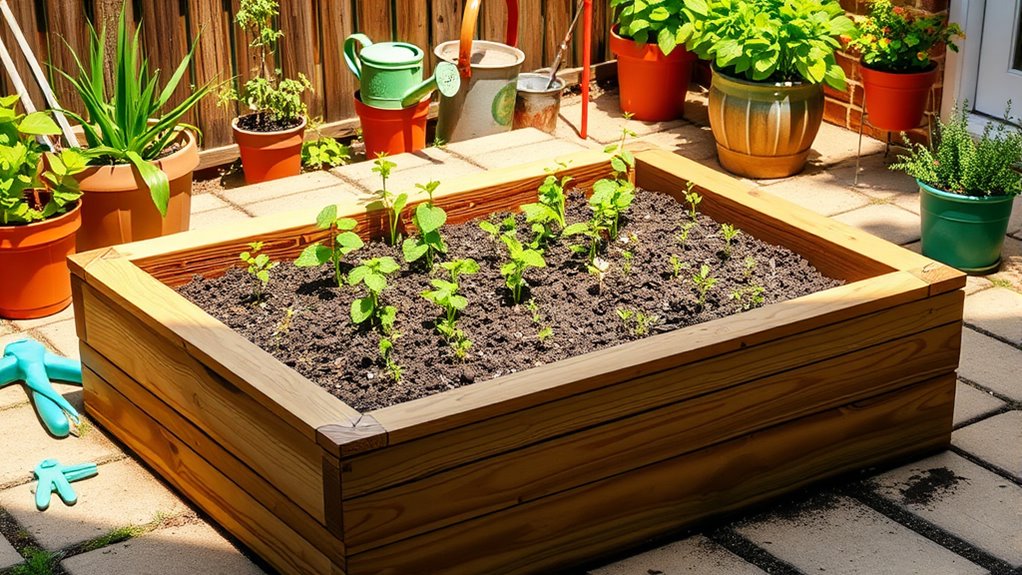
To make the most of your patio garden, get creative with container choices and layout ideas. Using a wood raised garden bed or a DIY raised bed made from weather-resistant materials like cedar or composite adds visual appeal.
Incorporate vertical gardening elements such as trellises or hanging planters to maximize limited space and promote healthy growth.
When building a raised bed, fill it with a mix of high-quality soil and compost, including garden soil and peat moss, for ideal nutrients and drainage.
Choose plants suited for container gardening, like herbs, leafy greens, and compact vegetables, to ensure success.
Consider adding a drip irrigation system with timers to maintain consistent moisture, reducing effort and supporting thriving plants in your raised beds.
Frequently Asked Questions
What Do I Put on the Bottom of a Raised Garden Bed on Concrete?
For the bottom of your raised garden bed on concrete, you should start with hardware cloth or galvanized wire mesh. This keeps pests like gophers out and prevents soil from seeping through.
Then, add a layer of gravel or small stones to improve drainage.
Cover the gravel with landscape fabric to prevent weeds and soil contact with the concrete.
This setup guarantees proper water flow and healthy root growth.
What Vegetables Should Not Be Grown in a Raised Bed?
They say, “Know your limits,” and that’s true for raised beds too. You should avoid planting root vegetables like parsnips and beets in poorly drained or compacted soil, as they struggle to form proper roots.
Large plants such as corn or squash need deep soil and ample space.
Also, steer clear of sensitive plants like potatoes that need pH balance, and crops prone to soil-borne diseases like celery and brassicas.
Is It Cheaper to Build or Buy a Raised Bed?
You’re wondering if building or buying a raised bed costs less. Generally, building it yourself is more affordable, especially if you already have tools and can find inexpensive materials like pine or treated wood.
DIY projects can cost between $50 and $150.
While ready-made beds often cost $200 to $500 or more.
How Do You Make an Outdoor Raised Garden Bed?
Think of building your outdoor raised garden bed as planting the first seed of your green thumb. To do it, choose rot-resistant lumber like cedar, measure and cut your boards to about 4×6 feet, and assemble the frame on a flat surface.
Line the inside with landscape fabric, fill with rich soil, and plant your favorite herbs or veggies.
Water regularly, and watch your garden flourish.
Conclusion
Now that you’ve built your raised garden bed, remember that patience is a virtue—great things take time. With careful planning, good materials, and regular care, you’ll enjoy a thriving patio oasis. Keep experimenting and learning as you go, because a garden is always a work in progress. Stick to the basics, nurture your plants, and you’ll see your efforts bloom into a beautiful, productive space. Happy gardening!
